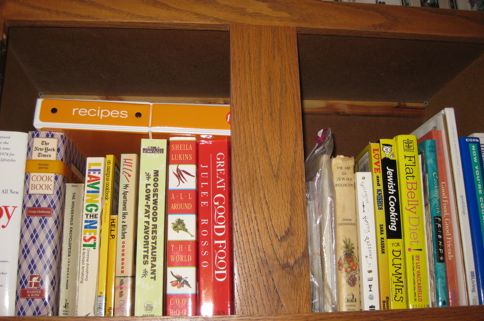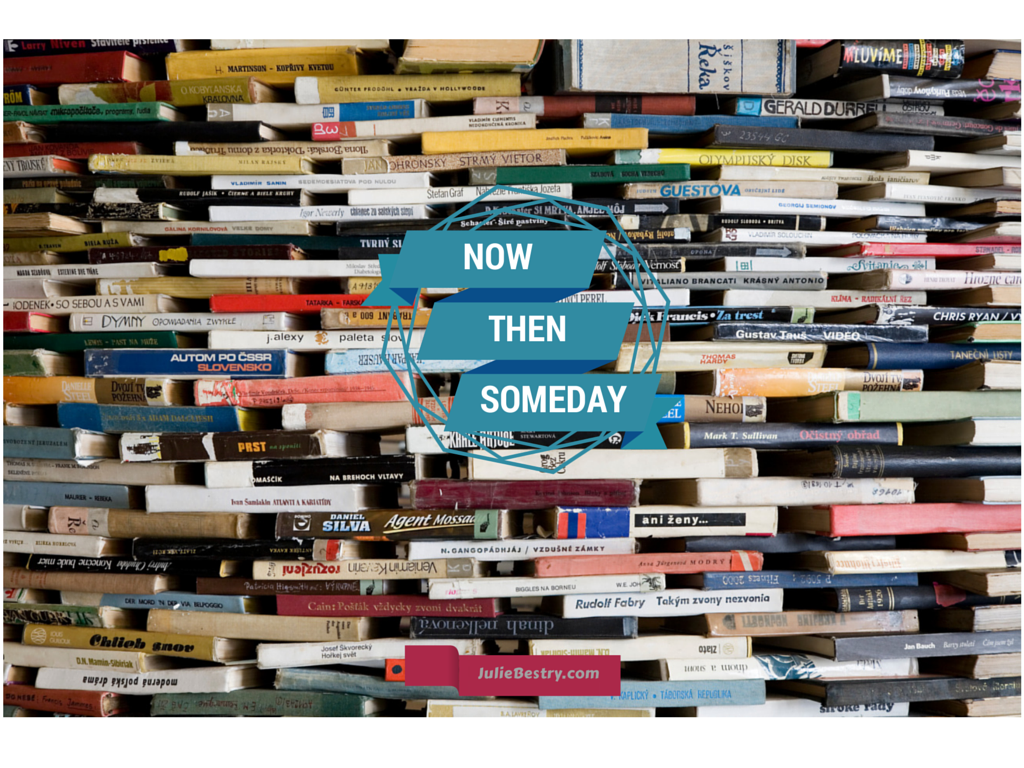Organizing Your Reading Space for More Reading Time
As you know, Paper Doll is a reader. Fiction. Non-fiction. Cereal boxes. Whatever there is to read, I’m eager to read it. But one of the complaints I hear from fellow readers is that while the spirit is willing, the flesh is weak. They want to read more books, but their busy lives and exhausted work/play-group/soccer-practice bodies don’t give them the time or opportunity to organize so that they can devour the new and classic titles for which they hunger.
Over the next few posts, we’re going to look at different ways to make it easier to read — what you should be reading (for work or school), what you want to be reading (for personal satisfaction or self-edification) or a combination of both (for socialization, like book clubs or just being in on the thing that everyone is discussing)!
DECLUTTER YOUR BOOK COLLECTION
It probably comes as no surprise that I believe you can’t really organize your time unless you organize your space. That begins with giving yourself permission to let go of what no longer fits.
Seriously. Let it go. (I’m sorry. I know that phrase has been Disneyfied straight into your cerebellum.)
 Lots of cookbooks for someone who relies on takeout sushi.
Lots of cookbooks for someone who relies on takeout sushi.
You’ve heard me say this before. Everything should have a home, but not everything has to live with you! The Pareto Principle, also called the 80/20 Rule, says that 80% of success comes from 20% of the effort, and it pretty much applies to your whole life. So, you may find that 80% of the time you are wearing (then washing, then re-wearing) the same basic 20% of your wardrobe; your kids are probably playing with the same 20% of their toys. That’s why paring things down gives you a much bigger bang for your buck than you expect…because you usually don’t miss the things you purge out, even though you probably thought you would, which is what kept you from downsizing in the first place.
This means letting go of books you read but hated, read but never plan to read again, got as a gift but don’t really want to read, or acquired for a different version of your life (one that you no longer lead). Even people who have no problem letting go of the rest of their possessions often still chafe at the idea of letting go of books, because readers know that in books, all the potential knowledge of the universe dwells. Well, that’s true, but if the knowledge is propping up your printer or gathering dust on a bedside table, that knowledge is being locked away in prison. Read it or set it free!
In previous Paper Doll posts, I’ve encouraged you to start the purging process by dividing books into three categories: Now, Then and Someday.
NOW books are the subjects, authors and titles that represent who you are today! They may be novels by authors you love or subjects you find compelling. For me, these would be my complete collection of Jane Austen, new novels like Charlie Lovett‘s forthcoming First Impressions, and recent books in my professional bailiwick, like The Organized Mind: Thinking Straight in the Age of Information Overload. Your own NOW books might be the latest thriller, some mouth-watering cookbooks, or a biography of Teddy Roosevelt (or, sigh, Kim Kardashian).
THEN books represent who you used to be. My THEN books covered all aspects of the television industry from the days I was a TV program director. By the time I became Paper Doll, I no longer needed to know the elements of a cause of action for a libel suit or how to calculate ratings and shares. If your youngest child is in middle school and the very idea of having another kid just made you shout obscenities at this family-friendly blog post, books about pregnancy and caring for newborns are so very THEN. As I’ve said before:
THEN books are like guests who have overstayed their welcomes. Consider the following alternatives for setting your THEN books free:
- Sell your books to a local used book store. Understand that you will get a tiny fraction of your original paid price. Instead, think of it as getting paid to recycle, like when you get a soda pop bottle deposit back.
- Sell your books online. (Amazon is the biggest and best-known option, but check out BookScouter for a Orbitz/Kayak-style search of all your price options.)
- Donate to your public library or school library. School libraries are often desperate for titles for their collections. Public libraries may be limited in what they’re allowed to select for circulation, but usually raise money by selling donated books at annual book sales.
- Donate books to hospital libraries, hospices, chemotherapy and dialysis treatment rooms, and community centers.
- Donate books to military personnel via projects like Books for Soldiers or Books for Troops.
- Donate your adult and YA titles, and textbooks, to incarcerated persons seeking to improve their literacy via programs like Prison Book Program.
- Set books free via Bookcrossing. (It’s not just a way to declutter; it’s a way to be part of “an unlikely global sociology experiment.”)
- Join the Little Free Library movement and share books with your neighbors and random passers-by.
SOMEDAY books represent who you wish (or once wished) to be someday. These are the publishing equivalent of the exercise videos that gather dust next to the TV. They’re the guides to speaking Italian or Urdu that you bought in hopes of learning an exotic language, the cookbooks for cuisines that are too complicated, too fattening or too much fuss for you to make…or the books on topics that represent your less relevant, if not less realistic, dreams.
Remember: Someday isn’t a date on the calendar. If you’ve decided that you’re starting a home-based business, books on writing business plans belong in your NOW collection; if you’ve been talking about starting a business for ten years but have never made any movement towards your goals, sell these books and let them fund a more current dream. Make space for your real life!
ORGANIZE YOUR LIBRARY SPACE & YOUR READING SPACE
These two zones may overlap, but unless you live (and read) in a dorm room or have a teeny studio apartment, your library and your reading area probably aren’t the same spaces. Start with two basic organizing guidelines:
- Things should live with others like them. As a professional organizer, this is a lesson I teach over and over, and it’s often an Ah-ha/lightbulb moment for clients. Put all your coffee mugs in the same cabinet. Let your shoes, except the ones on your feet right now, live in a little shoe commune in your closet. Your books should, generally, live together.
If you lack massive home library space, there’s no reason you can’t emulate official libraries with multiple collections in disparate spaces (e.g., children’s books in the kids’ rooms, cookbooks in the kitchen, non-fiction (including yearbooks and photo albums) in the den or living room). The key is that unless it’s the book you are currently reading, and unless it’s in your hand, your lap, your bag or under your eyeglasses on your bedside table, one lone book is likely to get buried and ignored. Books have stories to share — when they aren’t on the job, let them hang out with their friends.
- Things should live where they’re used. Reality check. If you have a big, comfy reading chair by the window in your bedroom — and yet you never sit in the big comfy reading chair, and the chair is covered with sedimentary rock-like layers of your wardrobe from the last few days, it’s not your reading chair. It’s your laundry chair.
Keep your main personal/family library where it best fits your home, but have your circulating library, your handful of borrowed library books, your current book club selection, and the novel you’ve been hacking away at, page by page, for months, in one small, defined space where you are actually reading. If you get all your reading done while rocking your baby to sleep, it’s alright to have your grownup books on shelf in the nursery next to currently nibbled-and-drooled-upon baby books. Your six-month-old won’t complain.
And if the only time you have to read your books is on your lunch hour, you have permission from a random blogger on the internet to keep your books, tidied by bookends, at the back of your desk against your cubicle wall.
[But don’t store books in your bathroom, even if you read them in the tub (or, y’know, elsewhere). Humidity and heat are bad for books.]
KNOW WHAT YOU HAVE SO YOU CAN READ WHAT YOU WANT
Finally, your library space will better serve you if you know what’s in it. The smaller your keep your collection, the less effort you’ll need to expend on putting your books in all but a rudimentary order, but if decluttering your library is an ongoing challenge, at least give yourself a chance to find what you want to read when the inspiration (and opportunity) strikes. The classic Paper Doll post, Shhhhh… We’re organizing the library… provides a good head start on no-tech, low-tech and more advanced ways to keep up with your library inventory; an eventual update on that post is in the works.
For more advice on keeping book clutter at bay so that you can find and focus on what you really want to read, be sure to revisit:
- Reducing Book Clutter (Part 1): Book Rentals for Grownups
- Reducing Book Clutter (Part 2): Book Rentals for Kids
- Reducing Book Clutter (Part 3): Trading Books Online (But keep to the “one-in, one-out” rule.)
- Reducing Book Clutter (Part 4): Borrowing & Returning–A Library Love Letter
- Reducing Book Clutter (Part 5): Electronic Books
- Reducing Book Clutter (Part 6): Audio Books
Next time, we’ll discuss how to carve organized space in your schedule so that reading doesn’t lose out to other activities in the competition for your time.





This was so inspiring, Julie! I’ve made peace with the fact that I am no longer DIRECTLY using my master’s degree, and that has been a very liberating process to “let it go.” But I have not yet let go of some of the books from that time in my life, which was 10 years and 5 moves ago. It’s time. I’m going to tackle that project this week! 🙂